Effect of repeated-pulse transcranial magnetic stimulation at the Guangming point on EEGs

In a recent study reported in the Neural Regeneration Research (Vol. 9, No. 5, 2014), repeated-pulse transcranial magnetic stimulation was administered to healthy people at the left Guangming (GB37) and a mock point, and calculated the sample entropy of electroencephalogram signals using nonlinear dynamics.
Additionally, researchers compared electroencephalogram sample entropy of signals in response to visual stimulation before, during, and after repeated-pulse transcranial magnetic stimulation at the Guangming.
Results showed that repeated-pulse transcranial magnetic stimulation at the Guangming evokes different patterns of electroencephalogram signals than repeated-pulse transcranial magnetic stimulation at other nearby points on the body surface, and that repeated-pulse transcranial magnetic stimulation at the Guangming is associated with changes in the complexity of visually evoked electroencephalogram signals in parietal regions, central gyrus, and temporal regions.
More information:
Zhang X, Fu LD, Geng YH, Zhai X, Liu YH. Analysis of the effect of repeated-pulse transcranial magnetic stimulation at the Guangming point on electroencephalograms. Neural Regen Res. 2014;9(5):549-554.
Provided by Neural Regeneration Research